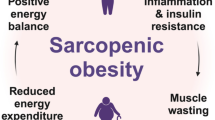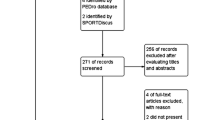Abstract
Background
The association between strength, assistance with walking, rise from a chair, climb stairs and falls (SARC-F), strength, assistance with walking, rise from a chair, climb stairs, falls and calf circumference (SARC-CalF), Ishii score chart, the short version of mini sarcopenia risk assessment (MSRA-5), the full version of mini sarcopenia risk assessment (MSRA-7) and clinical outcomes in patients with gastric cancer were unclear. We aimed to investigate the predictive values of the above five sarcopenia screening tools on clinical outcomes following surgery in patients with gastric cancer.
Methods
The clinical data of consecutive patients who would undergo gastrectomy from May 2020 to October 2020 at the First Affiliated Hospital of Nanjing Medical University were prospectively collected. On the first admission day, patients’ characteristics, Nutrition risk screening 2002 (NRS 2002), the above five sarcopenia screening tools and anthropometric measurements were preoperatively collected. Within 24 hours after discharge, operation information, tumor-node-metastasis (TNM) stage and clinical outcomes in hospital (postoperative complications, hospitalization expenditures and postoperative hospital stay) were collected. Three months after discharge, clinical outcomes out of hospital (hospital readmissions and mortality) were collected. Multivariate analyses were conducted to identify the independent predictors for clinical outcomes.
Results
A total of 263 patients were finally included in the study, with the average age being 62.44 years. The prevalence of sarcopenia risk ranged from 3.42% to 73.76%. For the above five sarcopenia screening tools, multivariate analyses showed that sarcopenia risk indicated by SARC-CalF was an independent predictor for postoperative complications (OR=3.145 [95%CI: 0.594, 16.665], P=0.037), prolonged postoperative hospital stay (B=2.383 [95%CI: 0.377, 4.388], P=0.020), increased hospitalization expenditures (B=1.305 [95%CI: 0.402, 2.208], P=0.005) and 3-month hospital readmissions (HR=3.626 [95%CI: 1.126, 11.676], P=0.031). Sarcopenia risk indicated by Ishii score chart was an independent predictor for postoperative complications (OR=6.491 [95%CI: 1.514, 27.840], P=0.012) and hospitalization expenditures (B=0.767 [95%CI: 0.065, 1.469], P=0.032). Sarcopenia risk indicated by MSRA-7 was an independent predictor for prolonged postoperative hospital stay (B=1.636 [95%CI: 0.119, 3.153], P=0.035)and increased hospitalization expenditures (B=0.831 [95%CI: 0.146, 1.516], P=0.018).
Conclusion
Among the above five sarcopenia screening tools, SARC-CalF seemed to have better predictive values on clinical outcomes. Preoperative gastric cancer patients with sarcopenia risk indicated by SARC-CalF could have a higher risk of postoperative complications, prolonged postoperative hospital stay, increased hospitalization expenditures and 3-month hospital readmissions.
Similar content being viewed by others
References
Sung H, Ferlay J, Siegel RL, Laversanne M, Soerjomataram I, Jemal A, et al. Global cancer Statistics 2020: GLOBOCAN estimates of incidence and mortality worldwide for 36 cancers in 185 countries[J]. CA Cancer J Clin, 2021;71(3):209–49, DOI: https://doi.org/10.3322/caac.21660
Oh SE, An JY, Choi MG, Sohn TS, Bae JM, Kim S, et al. Long term oncological outcome of patients with grossly early gastric cancer-mimicking advanced gastric cancer[J]. Eur J Surg Oncol, 2020;46(7):1262–68, DOI: https://doi.org/10.1016/j.ejso.2020.03.205
Cruz-Jentoft AJ, Bahat G, Bauer J, Boirie Y, Bruyere O, Cederholm T, et al. Sarcopenia: Revised European consensus on definition and diagnosis[J]. Age Ageing, 2019;48(1):16–31, DOI: https://doi.org/10.1093/ageing
Anker SD, Morley JE, von Haehling S. Welcome to the ICD-10 code for sarcopenia[J]. J Cachexia Sarcopenia Muscle, 2016;7(5):512–14, DOI: https://doi.org/10.1002/jcsm.12147
Tegels JJW, van Vugt JLA, Reisinger KW, Hulsewé KWE, Hoofwijk AGM, Derikx JPM, et al. Sarcopenia is highly prevalent in patients undergoing surgery for gastric cancer but not associated with worse outcomes[J]. J Surg Oncol, 2015;112(4):403–07, DOI: https://doi.org/10.1002/jso.24015
Hua H, Xu X, Tang Y, Ren Z, Xu Q, Chen L. Effect of sarcopenia on clinical outcomes following digestive carcinoma surgery: A meta-analysis[J]. Support Care Cancer, 2019;27(7):2385–94, DOI: https://doi.org/10.1007/s00520-019-04767-4
Janssen I, Shepard DS, Katzmarzyk PT, Roubenoff R. The healthcare costs of sarcopenia in the United States[J]. J Am Geriatr Soc, 2004;52(1):80–85, DOI: https://doi.org/10.1111/j.1532-5415.2004.52014.x
Dent E, Morley JE, Cruz-Jentoft AJ, Arai H, Kritchevsky SB, Guralnik J, et al. International clinical practice guidelines for sarcopenia (ICFSR): Screening, diagnosis and management[J]. J Nutr Health Aging, 2018;22(10):1148–61, DOI: https://doi.org/10.1007/s12603-018-1139-9
Lu J, Xu Q, Hua H, Xu X, Ding L. Advances in sarcopenia screening tools in the elderly[J]. Chin Gen Pract, 2020, 23(27): 3444–3448, DOI: https://doi.org/10.12114/j.issn.1007-9572.2020.00.423
Yang M, Jiang J, Zeng Y, Tang H. Sarcopenia for predicting mortality among elderly nursing home residents: SARC-F versus SARC-CalF[J]. Medicine (Baltimore), 2019;98(7):e14546, DOI: https://doi.org/10.1097/MD.0000000000014546
Tang T, Wu L, Yang L, Jiang J, Hao Q, Dong B, et al. A sarcopenia screening test predicts mortality in hospitalized older adults[J]. Sci Rep, 2018;8(1):2923, DOI: https://doi.org/10.1038/s41598-018-21237-9
Malmstrom TK, Morley JE. SARC-F: A simple questionnaire to rapidly diagnose sarcopenia[J]. J Am Med Dir Assoc, 2013;14(8):531–32, DOI: https://doi.org/10.1016/j.jamda.2013.05.018
Wang X. The localization and application in the SARC-F to assess sarcopenia in community-dwelling older adults and the effectiveness of exercise therapy on symptom improvement in older adults with sarcopenia: a meta-analysis[D]. Hebei Medical University, 2018, DOI: https://doi.org/10.7666/d.D01514858
Barbosa-Silva TG, Menezes AM, Bielemann RM, Malmstrom TK, Gonzalez MC. Enhancing SARC-F: Improving sarcopenia screening in the clinical practice[J]. J Am Med Dir Assoc, 2016;17(12):1136–41, DOI: https://doi.org/10.1016/j.jamda.2016.08.004
Fu X, Tian Z, Thapa S, Sun H, Wen S, Xiong H, et al. Comparing SARC-F with SARC-CalF for screening sarcopenia in advanced cancer patients[J]. Clin Nutr, 2020;39(11):3337–45, DOI: https://doi.org/10.1016/j.clnu.2020.02.020
Ishii S, Tanaka T, Shibasaki K, Ouchi Y, Kikutani T, Higashiguchi T, et al. Development of a simple screening test for sarcopenia in older adults[J]. Geriatr Gerontol Int, 2014;14 Suppl 1:93–101., DOI: https://doi.org/10.1111/ggi.12197
Li M, Kong Y, Chen H, Chu A, Song G, Cui Y. Accuracy and prognostic ability of the SARC-F questionnaire and Ishii’s score in the screening of sarcopenia in geriatric inpatients[J]. Braz J Med Biol Res, 2019;52(9):e8204, DOI: https://doi.org/10.1590/1414-431X20198204
Rossi AP, Micciolo R, Rubele S, Fantin F, Caliari C, Zoico E, et al. Assessing the risk of sarcopenia in the elderly: The mini sarcopenia risk assessment (MSRA) questionnaire[J]. J Nutr Health Aging, 2017;21(6):743–49, DOI: https://doi.org/10.1007/s12603-017-0921-4
Yang M, Hu X, Xie L, Zhang L, Zhou J, Lin J, et al. Validation of the Chinese version of the mini sarcopenia risk assessment questionnaire in community-dwelling older adults[J]. Medicine (Baltimore), 2018;97(37):e12426, DOI: https://doi.org/10.1097/MD.0000000000012426
Ali SF, Smith EE, Reeves MJ, Zhao X, Xian Y, Hernandez AF, et al. Smoking paradox in patients hospitalized with coronary artery disease or acute ischemic stroke: Findings from get with the guidelines[J]. Circ Cardiovasc Qual Outcomes, 2015;8(6 Suppl 3):S73–80, DOI: https://doi.org/10.1161/CIRCOUTCOMES.114.001244
Li Y, Wang J, Zhao L, Wang Z, Yu D, He Y, et al. The drinking status and associated factors in adults in China[J]. Chin J Epidemiol, 2018;39(7):898–903, DOI: https://doi.org/10.3760/cma.j.issn.0254-6450.2018.07.007
Kondrup J, Rasmussen HH, Hamberg O, Stanga Z. Nutritional risk screening (NRS 2002): A new method based on an analysis of controlled clinical trials[J]. Clin Nutr, 2003;22(3):321–36, DOI: https://doi.org/10.1016/s0261-5614(02)00214-5
Weng CH, Tien CP, Li CI, L’Heureux A, Liu CS, Lin CH, et al. Mid-upper arm circumference, calf circumference and mortality in Chinese long-term care facility residents: A prospective cohort study[J]. Bmj Open, 2018;8(5):e20485, DOI: https://doi.org/10.1136/bmjopen-2017-020485
Shechtman O, Gestewitz L, Kimble C. Reliability and validity of the DynEx dynamometer[J]. J Hand Ther, 2005;18(3):339–47, DOI: https://doi.org/10.1197/j.jht.2005.04.002
Tamura T, Sakurai K, Nambara M, Miki Y, Toyokawa T, Kubo N, et al. Adverse effects of preoperative sarcopenia on postoperative complications of patients with gastric cancer[J]. Anticancer Res, 2019;39(2):987–92, DOI: https://doi.org/10.21873/anticanres.13203
Cruz-Jentoft AJ, Sayer AA. Sarcopenia[J]. Lancet, 2019;393(10191):2636–46, DOI: https://doi.org/10.1016/S0140-6736(19)31138-9
Chen LK, Woo J, Assantachai P, Auyeung TW, Chou MY, Iijima K, et al. Asian Working Group for Sarcopenia: 2019 Consensus Update on Sarcopenia Diagnosis and Treatment[J]. J Am Med Dir Assoc, 2020;21(3):300–07, DOI: https://doi.org/10.1016/j.jamda.2019.12.012
Lu J, Xu Q, Chen L, Ding L, Hua H, Xu X. Comparison of the performance of 5 screening tools for sarcopenia in preoperative patients with gastric tumor[J]. Chin J Nurs, 2021, 56(9): 1299–1304, DOI: https://doi.org/10.3761/j.issn.0254-1769.2021.09.003
Wu TY, Liaw CK, Chen FC, Kuo KL, Chie WC, Yang RS. Sarcopenia screened with SARC-F questionnaire is associated with quality of life and 4-year mortality[J]. J Am Med Dir Assoc, 2016;17(12):1129–35, DOI: https://doi.org/10.1016/j.jamda.2016.07.029
Yang Z, Zhou X, Ma B, Xing Y, Jiang X, Wang Z. Predictive value of preoperative sarcopenia in patients with gastric cancer: A meta-analysis and systematic review[J]. J Gastrointest Surg, 2018;22(11):1890–902, DOI: https://doi.org/10.1007/s11605-018-3856-0
Rodrigues FW, Burgel CF, Brito JE, Baumgardt E, de Araujo BE, Silva FM. SARC-CalF tool has no significant prognostic value in hospitalized patients: A prospective cohort study[J]. Nutr Clin Pract, 2021;36(5):1072–79, DOI: https://doi.org/10.1002/ncp.10675
Acknowledgment
The authors would like to thank all the patient volunteers for their collaborative contribution in this project and for making this study possible.
Funding
Funding: This work was supported by National Natural Science Foundation of China (NSFC) (No. 82073407); NSFC (No. 72004099); People’s Government of Jiangsu Province ((2018) No.87).
Author information
Authors and Affiliations
Corresponding authors
Additional information
Declaration of competing interest
The authors report no conflicts of interest in this work.
These authors are co-first author.
Electronic Supplementary Material
Rights and permissions
About this article
Cite this article
Lu, JL., Xu, XY., Chen, L. et al. The Predictive Values of Five Sarcopenia Screening Tools on Clinical Outcomes Following Surgery in Patients with Gastric Cancer: A Prospective Cohort Study. J Nutr Health Aging 26, 259–265 (2022). https://doi.org/10.1007/s12603-022-1751-6
Received:
Accepted:
Published:
Issue Date:
DOI: https://doi.org/10.1007/s12603-022-1751-6




